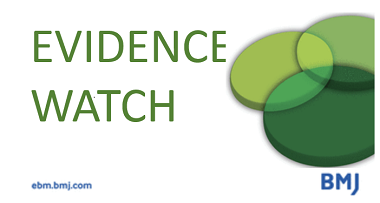Results of a recent review show a significant reduction in mortality with ICD. The effect, however, was weakened by the inclusion of the largest recent trial.
Carl Heneghan, Editor in Chief
 One essential element of determining if a trial is sufficiently robust enough to believe the results is that the control group received standard care practices. This ensures the intervention doesn’t perform better just because of inadequate or inferior care in the control group. For example, you may trial a new painkiller against an inferior dose of the standard one, and in doing this, you will come to the wrong conclusion about effectiveness.
One essential element of determining if a trial is sufficiently robust enough to believe the results is that the control group received standard care practices. This ensures the intervention doesn’t perform better just because of inadequate or inferior care in the control group. For example, you may trial a new painkiller against an inferior dose of the standard one, and in doing this, you will come to the wrong conclusion about effectiveness.
A recent Danish Study of Implantable Cardiac Defibrillators (ICDs) in patients with non-ischaemic cardiomyopathy suggested ICDs did not reduce mortality. The trial randomised patients to conventional therapy (medical treatment and a cardiac resynchronisation pacemaker if indicated) or an ICD and conventional treatment.
After a median 5.6 years, there was no reduction in all-cause death, despite a significant reduction in sudden cardiac death in the ICD group. More than half of the patients received cardiac resynchronisation, and when you add this to optimised medical therapy the risk of sudden death became so low in the control group there was little room for improvement – any additional intervention offers little absolute benefit.
This was not the case for older trials as a recent review suggests.
An updated systematic review that including the above trial found six primary prevention trials and two secondary prevention trials. Results show a significant reduction in mortality with ICD. The effect, however, was weakened by the inclusion of the largest recent trial.
The authors discuss that the risk of sudden death in older trials included patients treated sub-optimally compared to modern standards. For example, in one trial done in 2000, β-blocker were used in only 2/3rds of the patients. Absolute benefits will, therefore, diminish with reductions in the absolute rate of events, which can occur over time with improvements in usual care treatments and life expectancy.
References
Non-ischaemic cardiomyopathy, sudden death and implantable defibrillators: a review and meta-analysis. Heart. 2018 Jan;104(2):144-150. doi: 10.1136/heartjnl-2016-310850. Epub 2017 Oct 6.
Defibrillator Implantation in Patients with Nonischemic Systolic Heart Failure. N Engl J Med. 2016 Sep 29;375(13):1221-30. doi: 10.1056/NEJMoa1608029. Epub 2016 Aug 27.
Cardiac-resynchronization therapy with or without an implantable defibrillator in advanced chronic heart failure. N Engl J Med. 2004 May 20;350(21):2140-50.

BMJ Evidence-Based Medicine – original evidence-based research, insights and opinions on what matters for health care.
Read more about BMJ EBM content in the Welcome to BMJ Evidence-Based Medicine Editorial.
Carl Heneghan is Professor of EBM at the University of Oxford, Director of CEBM and Editor in Chief of BMJ EBM
Follow on twitter @carlheneghan
Competing interests
Carl has received expenses and fees for his media work including BBC Inside Health. He holds grant funding from the NIHR, the NIHR School of Primary Care Research, The Wellcome Trust and the WHO. He has also received income from the publication of a series of toolkit books published by Blackwells. CEBM jointly runs the EvidenceLive Conference with the BMJ and the Overdiagnosis Conference with some international partners which are based on a non-profit model.